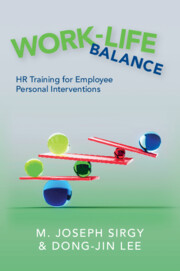Book contents
- Work-Life Balance
- Work-Life Balance
- Copyright page
- Contents
- Figures
- Tables
- Part I Making the Case for Work-Life Balance
- Chapter 1 Introduction
- Chapter 2 Why is Work-Life Balance Important?
- Chapter 3 How Does Work-Life Balance Contribute to Life Satisfaction?
- Part II Behavior-Based Personal Interventions of Work-Life Balance
- Part III Cognition-Based Personal Interventions of Work-Life Balance
- Part IV Epilogue
- Index
- References
Chapter 3 - How Does Work-Life Balance Contribute to Life Satisfaction?
from Part I - Making the Case for Work-Life Balance
Published online by Cambridge University Press: 19 January 2023
- Work-Life Balance
- Work-Life Balance
- Copyright page
- Contents
- Figures
- Tables
- Part I Making the Case for Work-Life Balance
- Chapter 1 Introduction
- Chapter 2 Why is Work-Life Balance Important?
- Chapter 3 How Does Work-Life Balance Contribute to Life Satisfaction?
- Part II Behavior-Based Personal Interventions of Work-Life Balance
- Part III Cognition-Based Personal Interventions of Work-Life Balance
- Part IV Epilogue
- Index
- References
Summary
In this chapter, we discuss much of the research that explains how work-life balance contributes significantly to life satisfaction. We explain the direct link between work-life balance and overall life satisfaction through satisfaction in multiple domains, positive spillover of domain satisfaction, and minimal role conflict. Furthermore, there are two indirect links, namely through domain satisfaction (satisfaction with marital life, family life, health and safety, and leisure life) and stress reduction (emotional exhaustion, psychological distress, and mental health).
- Type
- Chapter
- Information
- Work-Life BalanceHR Training for Employee Personal Interventions, pp. 25 - 38Publisher: Cambridge University PressPrint publication year: 2023



